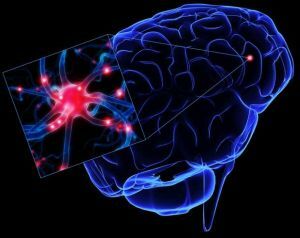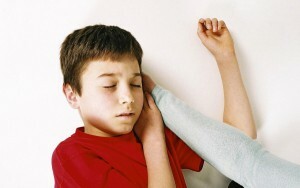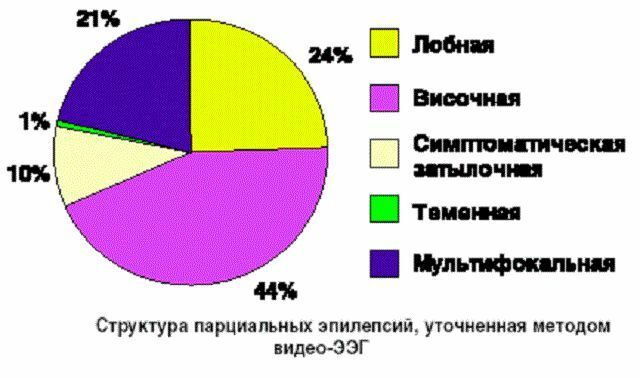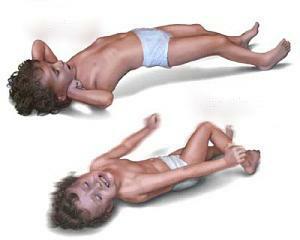 Epilepsy is a psychoneurological disease that manifests itself with sudden seizures. The disease proceeds in a chronic form.
Epilepsy is a psychoneurological disease that manifests itself with sudden seizures. The disease proceeds in a chronic form.
The mechanism of the development of seizures is associated with the emergence of multiple foci of spontaneous excitation in different parts of the brain, and accompanied by a disorder of sensory, motor, mental and vegetative activity.
The frequency of the disease is 1% of the total population. Very often seizures occur in children due to the high convulsive readiness of the child's organism, mild excitability of the brain and the generalized response of the central nervous system to stimuli.
There are so many different types and forms of epilepsy, we will go through the main types of disease and their symptoms in newborns, in children and adults.
Content
- disease
- newborn features epileptic seizures in children
- absence epilepsy
- rolandic epilepsy
- myoclonic form
- disease Post-traumatic epilepsy
- Alcohol injection in
- brain non-convulsive epilepsy
- epilepsy classification of areas of brain damage
- frontal form of epilepsy
- defeat in the temporal lobe
- Occipitalepilepsy
- Cryptogenic character of the disease
- Types of seizures
- Lavna
disease
Epilepsy newborn in the newborn is also called intermittent. Seizures are of a general nature, convulsions pass from one limb to another and from one side of the body to the other. Symptoms such as foam from the mouth, tongue snacking and postpristupnoe falling asleep are not observed.
Manifestations can develop against a background of high body temperature. After the consciousness returns, there may be weakness in one half of the body, and it can sometimes last for several days.
Symptoms that are harbingers of an attack include:
- irritability;
- lack of appetite;
- headache.

Features of epileptic seizures in children
The causes of epilepsy in children may be complications during pregnancy, infectious diseases of the brain, hereditary predisposition.
Main symptoms:
- convulsions in the form of rhythmic contractions;

- short-term breathing delay;
- uncontrolled emptying of the bladder and intestines;
- disconnection of consciousness;
- stiffness of muscles and as a consequence - stiffness of limbs;
- tremor of hands and feet.
Pediatric epilepsy can be expressed in forms of a different type, the characteristics of which can not be determined immediately.
Absence epilepsy
Absence epilepsy is characterized by the absence of convulsions and loss of consciousness. Man seems to freeze and lose orientation in space with no reaction. Symptoms:
- sudden fading;
- is absent or, on the contrary, focused in one point view;
- lack of attention.
Often the disease debuts at preschool age. On average, the duration of the symptomatology is 6 years, then the symptoms either go completely or flow into another epileptic form. Girls are prone to illness more often than boys.
Rolandic epilepsy
One of the most common types of epilepsy in children. It is noted at the age of 3 to 14 years. In this case, most boys are sick. Symptoms:
- numbness of facial skin, gums, tongue, larynx muscles;
- speech difficulties;
- abundant drooling;
- clonic one-sided and tonic-clonic seizures.
Attacks mainly occur at night and have a short-term course.

Types of epilepsy in the ICD 10
Myoclonic form of the disease
Myoclonic epilepsy affects people of both sexes. One of the most common species. The disease debuts at the age of 10 to 20 years. Symptoms are manifested by epileptic seizures.
Over time, there are myoclonias - involuntary muscle contractions. Very often there are mental changes.
The frequency of seizures can be completely different. They can happen every day, or several times a month or even less often. Along with seizures, there may be disorders of consciousness. However, it is this form of the disease that is most easily amenable to therapy.
Posttraumatic epilepsy
 This form of epilepsy develops as a result of brain damage in head injuries. Symptoms manifest themselves in convulsive attacks. This type of epilepsy occurs in about 10% of the affected people who suffered such trauma.
This form of epilepsy develops as a result of brain damage in head injuries. Symptoms manifest themselves in convulsive attacks. This type of epilepsy occurs in about 10% of the affected people who suffered such trauma.
The probability of a pathology increases to 40% with a penetrating brain injury. Characteristic signs of the disease can occur not only in the near future after the lesion, but also after a few years from the time of injury. They will depend on the site of pathological activity.
Alcohol injection into the brain
Alcoholic epilepsy is one of the hardest consequences of alcoholism. Characterized by sudden convulsive seizures. The cause of the pathology is a prolonged alcohol intoxication, especially against the background of poor-quality drinks. Additional factors are infectious diseases of the brain, suffered head trauma, atherosclerosis.
May occur in the first few days after the cessation of alcohol use. At the beginning of the attack, there is a loss of consciousness, then the face becomes very pale, there is vomiting and foam from the mouth. The fit ends as the consciousness returns to the person. After a seizure, a prolonged sound sleep occurs. Symptoms:
- syncope;
- convulsions;
- burning pain;
- skin tightening sensation;
- hallucinations.
Bessodorozhnaya epilepsy
This form is a frequent variant of the development of the disease. The symptomatology is expressed in personal changes. Can last from several minutes to several days. Disappears as suddenly as it begins. 
In this case, an attack is understood as a narrowing of consciousness, while the perception of patients surrounding the reality is focused only on emotionally significant for him phenomena.
The main symptom of this form of epilepsy is hallucination, having a frightening overtones, as well as the expression of emotions in extreme degree of their expression. This type of disease accompanies mental disorders. After attacks, a person does not remember what happened to him, only occasionally there may be residual memories of events.
Classification of epilepsy by brain damage zones
There are the following types of disease in this classification.
Frontal epilepsy
Frontal epilepsy is characterized by the location of pathological foci in the frontal lobes of the brain. Can manifest at any age.
Seizures occur very often, do not have regular intervals, and their duration does not exceed a minute. Start and end suddenly. Symptoms:
- sensation of fever;
- random speech;
- meaningless movement.
A special variant of this form is night epilepsy. It is considered the most favorable variant of the disease. In this case, convulsive activity of the neurons of the pathological focus increases at night. Because excitation is not transmitted to neighboring sites, seizures flow more gently. Nighttime epilepsy is accompanied by such conditions as:
- somnambulism - performing any active activity at the time of sleep;
- parasomnia - uncontrolled flinches of limbs at the time of awakening or retirement;
- enuresis - involuntary urination.
Lesion in the temporal lobe
Temporal epilepsy develops due to a variety of factors, such as birth trauma, temporal lobe damage during head injury, or inflammatory processes in the brain. Characterized by the following short-lived symptoms:
- nausea;
- abdominal pain;
- spasms in the intestine;
- heart palpitations and heart pain;
- shortness of breath;
- profuse sweating.
Also there are changes in consciousness, such as loss of motivation and performance of meaningless actions. In the future, pathology can lead to social maladaptation and pronounced vegetative disorders. The disease is chronic and progresses over time.

Occipital epilepsy
Occurs in small children aged 2 to 4 years, has a benign character and favorable prognosis. The causes can be various neuroinfections, tumors, congenital malformations of the brain. Symptoms:
- visual disturbances - there are lightning, flies before the eyes;
- hallucinations;
- tremor of the head;
- rotation of eyeballs.
Cryptogenic nature of the disease
This type of disease is spoken in the case when it is impossible to identify the main cause of the onset of convulsive attacks.
Symptomatic of cryptogenic epilepsy will directly depend on the location of the pathological focus in the brain.
Often, such a diagnosis is of an intermediate nature, and as a result of further testing, it is possible to determine the specific form of epilepsy and prescribe a therapy.
Types of seizures
Epileptic seizures are classified into groups according to the source of the epileptic impulse. There are two main types of seizures and their sub-types.
Seizures in which the discharge begins in localized areas of the cerebral cortex and has one or more foci of activity, are called partial( focal).Attacks characterized by simultaneous discharges in the cortex of both hemispheres are called generalized.

The main types of epileptic seizures:
- With partial attacks, the main focus of epileptic activity is most often localized in the temporal and frontal lobes. These seizures can be simple with the preservation of consciousness, when the discharge does not extend to other areas. Simple seizures can turn into complex ones. Complex can be symptomatically similar to simple, but in this case there always is a disconnection of consciousness and characteristic automated movements. Also, partial seizures with secondary generalization are isolated. They can be simple or complex, but the discharge spreads to both hemispheres and is transformed into a generalized or tonic-clonic attack.
- Generalized seizures are characterized by the appearance of a pulse that affects the entire cortex of the brain from the onset of an attack. Such attacks begin without a prior aura, loss of consciousness occurs immediately.
Generalized seizures include tonic-clonic, myoclonic seizures and absence:
- For tonic-clonic seizure is characterized by tonic muscle tension, breathing disorder( until it stops, in which there is no choking), increased blood pressure and frequent heartbeats. The duration of the attack is a few minutes, after it a person feels weak, deaf, deep sleep can come.

- Abscesses are non-convulsive seizures with a brief unconsciousness. The frequency of absences can reach several hundred per day, their duration does not exceed half a minute. Characterized by a sudden interruption of activities, a lack of response to the surrounding reality and a glare. Such seizures may be the first signs of the onset of epilepsy in children.
- The myoclonic seizures of are most typical for the puberty period, but it is likely that they may occur within the age of 20 years. Characterized by the preservation of consciousness, sharp and fast twitching of hands, increased sensitivity to light. Come a few hours before sleep or a couple of hours after awakening.
Semiology of epileptic seizures:
Briefly about the main
Treatment of epilepsy has two directions - medical and surgical. Medicamentous consists in the appointment of a complex of anticonvulsant drugs affecting a certain area of the brain( depending on the localization of the pathological focus).
The main objective of this therapy is to stop or significantly reduce the number of seizures. Medications are prescribed individually, depending on the type of epilepsy, the patient's age and other physiological characteristics.
 If the disease progresses, and treatment with drugs remains unsuccessful, surgical intervention is performed. Such an operation is the removal of pathologically active zones of the cerebral cortex.
If the disease progresses, and treatment with drugs remains unsuccessful, surgical intervention is performed. Such an operation is the removal of pathologically active zones of the cerebral cortex.
In the event that epileptic pulses occur in areas that can not be removed, cuts in the brain are performed. This procedure prevents their transition to other sites.
In most cases, patients who have undergone the surgery will not have seizures anymore, but for a long time they still need to take medications in small doses to reduce the risk of returning seizures.
In general, the therapy of this disease is focused on creating conditions that will ensure the rehabilitation and normalization of the patient's condition at the psycho-emotional and physical level.
With properly selected and adequate treatment, it is possible to achieve very favorable results, which will help to lead a full-fledged lifestyle. However, such people should adhere to the correct regime throughout their life, avoid falling asleep, overeating, staying at high altitude, the impact of stress and other unfavorable factors.
It is very important to refrain from taking coffee, alcohol, drugs and smoking.



